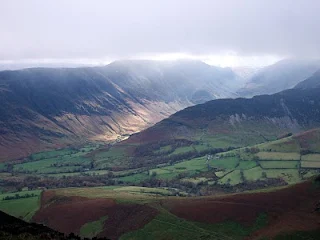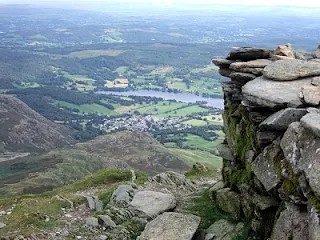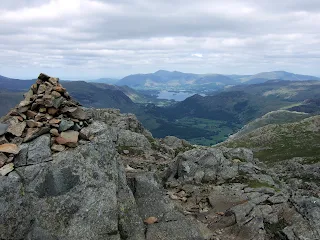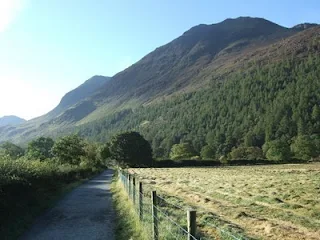
The familiar outline of Causey Pike is prominent in the western panorama from Keswick and Derwentwater and the popular climb to its summit is a fine route whether done on its own or as part of the ridge route terminating at Eel Crag (Crag Hill on OS maps). This route is a circular outing that goes as far as Sail (just beyond the Sail Pass) and returns over the lesser but no less interesting peaks of Outerside and Barrow. It could be extended to Crag Hill - which was considered - though more retracing of steps would be involved and the weather did not encourage a longer trip today.
Leaving the car at an ample roadside space on the Newlands Road just over a mile south of Braithwaite I set off south along the road towards the precipitous looking slopes of Rowling End - the eastern spur of Causey Pike - which was my first objective. The path on the right is our return route and is not a short cut to Causey Pike. There is another free parking place just along the road here so please do not abandon vehicles in the passing places - you will not be thanked for it!
As soon as I had crossed the beck by a small bridge, a path led off up the steep slopes to my right. It was a relief to start the climb as it was not a warm day - only 4 degrees C at valley level and breezy with it. The path led easily at first up the valley with the beck down on the right and Causey Pike rising steeply to the clouds ahead. The main path carries on climbing across the slope but after a short while I took a steeper path that ascended through the heather to the left. The main route is okay but this path ascends to the top of the spur of Rowling End and provides superior views up the Newlands Valley once the top is gained.
This way was steep though and hands were needed in a few places as easy rock passages were encountered. It was more that the rock was slippery than difficuly but the views were worth the extra effort and I soon found myself on a wide heathery ridge top with the wild scene of the head of the Newlands valley bounded by High Spy and Dale Head, contrasting with the wooded shores of Derwentwater beyond the fields and farmhouses of the dale below.
Ahead was the steep cone of Causey Pike , mist clinging to the summit crags. It reminded me from here, of a smaller and tamer version of the Matterhorn with the rocky bulge just below the summit. I passed the point where the main path reaches the ridge - Sleet Hause - and started up the ridge.
A good path led without difficulty up the ridge and I gained height quickly soon finding myself below the rocky section. The path heads more or less straight up this rocky dome and while the hands are certainly needed, the way up is much easier than it appears from below then - just as the steepness eases - you are on one of the finest summits in the region. The highest point is the top of the steep rocky bulge seen from below though as the rocks are surmounted one reaches a small grassy platform.
It was a shame that I had reached the cloud layer as the view - which had improved with height would have been excellent from this eagle's nest of a vantage point. The top of Causey Pike is made up of several - 5 I think - bumps which are visible in views of the fell from below. The path now led sucessively over these. The first one appears to be the highest but there's not much between it and the third one. There was no mistake about the route now - on along the ridge through a chill windblown fog towards the next peak - Scar Crags - itself invisible about a kilometre ahead.
The ridge widened for a while and a constructed raised pathway traversed some damp looking areas before a steady ascent brought me to the top of Scar Crags where the view matched that from Causey Pike exactly - a circle of turf and stones beyond which existed only a cold rushing blankness.
The path led on down the far side into the mist and I was soon at Sail Pass where this trail crosses the one linking Braithwaite and Buttermere. The logical circular route here branches right on the Sail Pass towards Braithwaite but with a nod in the direction of peak bagging I decided to ascend Sail before heading down that way. The summit is not much further and was one of the Wainwrights I hadn't climbed before. I had originally planned to go as far as Eel Crag aka Crag Hill but I had been there not so long ago in better weather than this and it would mean retracing my steps if I wanted to visit Outerside. Besides my planned descent of Crag Hill by the Shelf Route - also a fine route of ascent - from Coledale requires clear weather.
Heading up the easy slope to Sail on the wide path, the landscape subtly changed. Sprigs of heather and longer strands of grass beside the path became tinged with white hoar frost and the small patches of snow ceased to be soft. At 2400 feet I had reached the freezing level or 0 degree isotherm. Thanks to the mist I had also entered what aircraft pilots call icing conditions where cloud droplets freeze on contact with solid objects in this case clothing which is far less of a problem than the control surfaces of an aircraft. The forecast snow had not arrived though.
The top of Sail was a cheerless place in this weather and I set off back down to the pass where I emerged below the mist to the wild scene of upper Coledale with the ruined mine below the waterfall at its head. The cloud hid the surrounding summits from view and their rough slopes dropped from the mist. I was passed by 2 girls who had been on Sail and were also heading for Outerside which was the interesting looking cone shaped hill in front that was currently free from mist.
After I had eaten most of my lunch I set off down the track on the Coledale side in a roughly north easterly direction. This is an interesting path across the rough slopes of Scar Crags high above the valley and it led to more level ground where I branched off left towards Outerside. This was grassy terrain and became quite boggy for a while before I found solid ground that led easily up to the fine stony summit of Outerside. These smaller fells are often unjustly neglected yet they can be just as enjoyable to climb as the major fells. The 2 girls had headed up here but no-one else had. They must be doing the Wainwrights as well!
I walked down the ridge towards the expansive views of Keswick, Derwentwater and the lower slopes of Skiddaw and passed the 2 girls again - they must have thought I was following them! The ridge steepened down to a damp heathery plateau interlaced with many small paths. I kept to the right of Stile End - the hill ahead - and found a path that descended to the right where I arrived at the col between this and the next hill known simply as Barrow. The route over Outerside is longer but much more of a joy than the main path in the valley below. I would rejoin it lower down after conquering Barrow.
A clear path led onwards along the ridge and 10 minutes or so brought me to the top of Barrow - only 455m or 1493 feet but commanding a wonderful view of the vale of the Derwent as well as Newlands directly below in the fading light of late afternoon. There's no safe route straight down so to get down there I retraced my steps towards the col I had just left. Here I met the 2 girls again and they were doing the Wainwrights - why else would anyone be up here at this hour? They'd had a good day out but were now faced with a drive back to London - I did not envy them! They had been the only people I had seen since my descent to Sail Pass.
From the col I cut straight down the fellside where a small path joinrd up with the main one below on which I turned left down the valley. This path rounded the corner in the valley and followed the road along to where I was parked. I saw no-one along here either.
Pete Buckley November 2010
Summits >>> Causey Pike 637m/2090ft >>> Scar Crags 672m/2205ft >>> Sail 773m/2536ft >>> Outerside 568m/1864ft >>> Barrow 455m/1493ft
Essentials >>> Up 970m >>> Down 970m >>> How Far? 12km >>> Start and finish at the Newlands Road near Stair >>>








